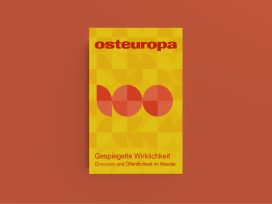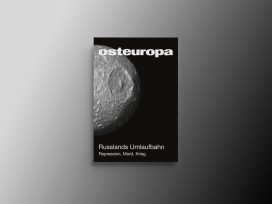Abstracts Osteuropa 9/2005
Stefan Auer
Power and violence. 1989, Ukraine, and the idea of revolution free of violence
The Orange Revolution in Ukraine and the Rose Revolution in Georgia drew
from central Europe’s experience in 1989. In each case, these
revolutions made a new start in politics that would have been
unthinkable under the ancien régime. As a result, revolution gained a
new definition, a definition characterized by self-limitations and a
lack of violence. Hannah Arendt’s reflections on the relationship
between power and violence provide valuable insight into the meaning of
this definition of revolution and its political implications.
Iris Kempe
A new “Ostpolitik”. Europe’s response to the rainbow revolutions in eastern Europe
The rainbow revolutions in Ukraine and Georgia were oriented to Western
values. Successful transformation in these states depends on their being
incorporated into the Western sphere of integration. In introducing its
Neighbourhood Policy, the European Union was responding to pressure to
act. Now, the European Union itself is in the middle of an integration
crisis. At the same time, the Kremlin has also failed in its strategy to
integrate the post-Soviet realm by means of dependency and personal
networks. A new east European policy is needed to shape the overlapping
spheres of integration between Russia and the West.
Alexander S. Neu
Kosovo’s future from the standpoint of international and constitutional law
The solution of the Kosovo problem is akin to squaring the circle. The
political demands of both sides, the Serbs and the Kosovo Albanians, are
diametrically opposed to one another. The West itself has played an
inglorious role: A former warring party, it is now trying to free itself
from this role and to negotiate as an “honest broker”. The sound basis
for this would be to return to the foundations of international law.
Boguslaw Bakula
At the border posts of Europe and Asia. The poet Jaroslaw Iwaszkiewicz
The Polish poet and writer Jaroslaw Iwaszkiewicz, who was born in
Ukraine and whose extensive work reflects the European conscious in the
twentieth century, wandered a good part of his life between two worlds:
between eastern and western Europe. For him, Kiev and St Petersburg, two
metropolises in the eastern part of the continent, were symbols of a
unity between East and West, youth and old age, life and death, that was
hard to achieve. They served him as a pretext for approaching
historical, metaphysical, and ethical lines of inquiry. Kiev appears in
his poetry as the gateway to the East and as the place where he was
initiated into the world of poetry. St Petersburg by contrast is a place of
dark powers and fatalist history, a place where one’s own existence and
identity are constantly under threat.
Gasan Guseinov
The internal world abroad. New boundaries in post-Soviet Russian literature
How have the cultural boundaries in contemporary Russian literature
shifted? Evtushenko’s dictum – “In Russia, a poet is more than just a
poet” – is no longer valid. Viktor Erofeev even buried Soviet literature. With
that, several boundaries were overcome – those between literature as high
art and fiction for the masses, between the refined world of the ivory
tower and pop culture. To interpret Russia’s late-blossoming
postmodernism, it is useful to apply the term “internal world abroad”
to the literary scene.
Dmitrii Khmelnickii
The struggle for Soviet architecture. Foreign architects in the USSR during the Stalin era
In the 1920s, the Soviet Union was still considered a showcase for the
future of architecture and thus attracted luminaries such as Le
Corbusier or Erich Mendelsohn. However, in the 1930s, the situation
changed radically. Stalin invited Western experts such as Albert Kahn or
Ernst May to collaborate in “socialist industrialization” and the
construction of the Soviet arms industry. Once the transfer of
military-industrial know-how reached a point where the Soviet Union no
longer needed Western architects and experts, Stalin abruptly broke off.
Klaus Müller
Europe, not Brussels. The World Congress of East European Studies
The swan song to East European Studies and area studies intoned in the
1990s has turned out to be premature. Excessively generalizing models
and the pseudo-experimental language of “variables” and “peripheral
conditions” have shown themselves to be inadequate for explaining
various developments in eastern Europe. Even simply transferring to the
East theories of integration learned from the European Union’s
experience falls short of the mark. Theory-driven regional knowledge is
needed for the comparative Europeanization of East European Studies.
Herta Schmid & Katrin Berwanger
Memorandum on the state of Slavic Studies in Germany
The list of Polish, Czech, and Russian Nobel laureates for literature,
Slavic painters, composers, and directors, the achievements in
philosophy, logic, rhetoric, theology, modern linguistics, aesthetics,
and literary theory is long. Names such as Comenius, Bolzano, Dvorak,
Kandinskii, Wajda, Stanislavskii, Rimskii-Korsakov, Szymborska, Mrozek,
Capek, and Havel are known around the world. But who in Germany can
truly appreciate their contributions to European culture? Given the
centuries of close interaction between German and Slavic cultures in
art, literature, business and commerce, political thought, and religion,
it is time German institutes of higher learning also overcome the
disastrous division of Europe that followed the Second World War. Slavic
cultures constitute a part of European culture and learning that is just
as important as Western culture. They can no longer be marginalized.
Published 30 October 2005
Original in German
Contributed by Osteuropa © Osteuropa
PDF/PRINTNewsletter
Subscribe to know what’s worth thinking about.



